The United Nations Educational, Scientific and Cultural Organization (UNESCO) World Heritage Sites are places of importance to cultural or natural heritage as described in the UNESCO World Heritage Convention, established in 1972.[1] Italy ratified the convention on June 23, 1978, making its historical sites eligible for inclusion on the list.[2] As of 2017, Italy has a total of 53 inscribed properties, making it the state party with the most World Heritage Sites.[3]
Sites in Italy were first inscribed on the list at the 3rd Session of the World Heritage Committee, held in Cairo and Luxor, Egypt in 1979. At that session, one site was added: the "Rock Drawings in Valcamonica".[4] A total of 25 (approximately half), of all Italian sites were added during the 1990s (where it was a member of the World Heritage Committee for the entire decade) with 10 sites added at the 21st session held in Naples, Italy in 1997, causing other countries to brand UNESCO as a 'biased Italian organization' from time to time. Italy has served as a member of the World Heritage Committee four times, specifically, 1978-1985 (8 years), 1987-1993 (7 years), 1993-1999 (7 years), and 1999-2001 (3 years).[5]
Out of Italy's 53 heritage sites, five are shared with other countries: "Monte San Giorgio" and "Rhaetian Railway in the Albula / Bernina Landscapes" with Switzerland; "Historic Centre of Rome" with the Vatican; "Prehistoric pile dwellings around the Alps" with Austria, France, Germany, Sloveniaand Switzerland; and "Venetian Works of Defence between 15th and 17th centuries: Stato da Terra – western Stato da Mar with Croatia and Montenegro. Four World Heritage Sites in Italy are of the natural type, all others are cultural sites (47). Therefore, Italy has the largest number of world "cultural" heritage sites followed by Spain with 39 cultural sites.[2]
Contents
[hide]World Heritage Sites[edit]
The table lists information about each World Heritage Site:
- Name: as listed by the World Heritage Committee[6]
- Location: city and region of site
- Area: size of property and buffer zone
- UNESCO data: the site's reference number; the year the site was inscribed on the World Heritage List; the criteria it was listed under: criteria i through vi are cultural, while vii through x are natural; (the column sorts by year added to the list)
- Description: brief description of the site
- The exhibition: A multi-sensory itinerary through the rich cultural and artistic heritage of the country, which recreates the atmosphere of some of the most fascinating places, recognized as a World Heritage Site.
* Trans-border site
| Name | Image | Location | Area ha (acre) | UNESCO data | Description |
|---|---|---|---|---|---|
| 18th-Century Royal Palace at Caserta with the Park, the Aqueduct of Vanvitelli, and the San Leucio Complex |  | Provinces of Caserta and Benevento, Campania 41°4′24″N14°19′35″E | 87 (210); buffer zone 111 (270) | 549; 1997; i, ii, iii, iv | Large scale palace and park created by the Bourbon King of Naples Charles III in the mid 18th century. It is notable for blending into the environment. The site also includes an ambitious new town and industrial complex.[7] |
| Arab-Norman Palermo and the Cathedral Churches of Cefalù and Monreale |  | Province of Palermo, Sicily 38°6′39″N13°21′11″E | 6.24 (15.4); buffer zone 483 (1,190) | 1487; 2015; ii, iv | The new Norman rulers started to build various constructions in what is called the Arab-Norman style. They incorporated the best practices of Arab and Byzantine architecture into their own art.[8] |
| Archaeological Area and the Patriarchal Basilica of Aquileia | 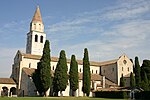 | Province of Udine, Friuli-Venezia Giulia 45°46′6″N13°22′3″E | 155 (380) | 825; 1998; iii, iv, vi | Remains of one of the wealthiest cities of the Early Roman Empire including mosaic floors and a basilica that played a major role in spreading Christianity in the early Middle Ages.[9] |
| Archaeological Area of Agrigento | 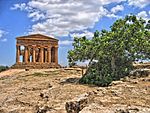 | Province of Agrigento, Sicily 37°17′23″N13°35′36″E | 934 (2,310); buffer zone 1,869 (4,620) | 831; 1997; i, ii, iii, iv | Well preserved remains of a great city of the ancient Mediterranean with seven doric temples making it one of the most notable sites of Greek art and culture.[10] |
| Archaeological Areas of Pompei, Herculaneumand Torre Annunziata |  | Province of Naples, Campania 40°45′0″N14°29′0″E | 98 (240); buffer zone 24 (59) | 829; 1997; iii, iv, v | Remains of two towns that had been buried by an eruption of Vesuvius in AD 79; giving an unmatched picture of ancient daily life at a specific moment in time.[11] |
| Assisi, the Basilica of San Francesco and Other Franciscan Sites |  | Province of Perugia, Umbria 43°3′58″N12°37′21″E | 14,563 (35,990); buffer zone 4,087 (10,100) | 990; 2000; i, ii, iii, iv, vi | Medieval city with notable pieces of art and architecture; birthplace of the Franciscan order.[12] |
| Botanical Garden (Orto Botanico), Padua |  | City and Province of Padua, Veneto 45°23′57″N11°52′50″E | 2.20 (5.4); buffer zone 11 (27) | 824; 1997; ii, iii | World's first botanical garden has been a center of scientific research and retains its original layout from 1545.[13] |
| Castel del Monte |  | Andria and Corato, Province of Bari, Apulia 41°5′5″N16°16′15.4″E | 3.10 (7.7); buffer zone 10,847 (26,800) | 398; 1996; i, ii, iii | Built by Emperor Frederick II in the 13th century, the castle blends northern European Cistercian gothic, Muslim architecture and elements from the classical antique in a perfectly symmetrical design.[14] |
| Cathedral, Torre Civicaand Piazza Grande, Modena | City and Province of Modena, Emilia–Romagna 44°38′46″N10°55′32″E | 1.20 (3.0); buffer zone 1.10 (2.7) | 827; 1997; i, ii, iii, iv | This 12th century cathedral built by Lanfranco (architect) and Wiligelmo (sculptor) is an excellent example of early Romanesque art.[15] | |
| Church and Dominican Convent of Santa Maria delle Grazie with "The Last Supper" by Leonardo da Vinci | Milan, Lombardy 45°27′57″N9°10′14″E | 1.50 (3.7) | 93; 1980; i, ii | The convent houses the mural painting "The Last Supper", a masterpiece by Leonardo da Vinci and one of the world's most famous paintings.[16] | |
| Cilento and Vallo di Diano National Park with the Archeological sites of Paestum and Velia, and the Certosa di Padula |  | Province of Salerno, Campania 40°17′0″N15°16′0″E | 159,110 (393,200); buffer zone 178,101 (440,100) | 842; 1998; iii, iv | Exceptional cultural landscape with settlements and sanctuaries reflecting its historical position on a trade route and related cultural and political exchange in prehistoric and medieval times. The site includes Paestum and Velia, remains of two major towns from classical times.[17] |
| City of Verona | City and Province of Verona, Veneto 45°26′19″N10°59′38″E | 453 (1,120); buffer zone 431 (1,070) | 797; 2000; ii, iv | Historical city that preserves urban structures and architecture from 2,000 years of uninterrupted development.[18] | |
| City of Vicenza and the Palladian Villas of the Veneto |  | Provinces of Padua, Rovigo, Treviso, Venice, Verona and Vicenza, Veneto 45°32′57″N11°32′58″E | 334 (830) | 712; 1994;[nb 1] i, ii | Urban buildings and villas in the surrounding Veneto region designed by Andrea Palladio had a major influence and architecture and inspired the Palladian style.[19] [20] |
| Costiera Amalfitana |  | Province of Salerno, Campania 40°39′0″N14°36′0″E | 11,231 (27,750) | 830; 1997; ii, iv, v | Outstanding example of a Mediterranean coastal landscape with notable architecture and art as well as a rural landscape testifying to the adaptation to the diverse mountainous landscape.[21] |
| Crespi d'Adda | Province of Bergamo, Lombardy 45°35′36″N9°32′18″E | — | 730; 1995; iv, v | Well preserved and partially in use company town built in the 19th and 20th centuries for the workforce of a textile manufacturer. The town includes both residential buildings and common public services such as a clinic, a school, theatre or sports centre.[22] | |
| Early Christian Monuments of Ravenna | City and Province of Ravenna, Emilia-Romagna 44°25′13.5″N12°11′46.5″E | 1.32 (3.3) | 788; 1996; i, ii, iii, iv | Unique collection of high quality early Christian mosaics from as early as the 5th century at a former seat of the Roman Empire and later of Byzantine Italy.[23] | |
| Etruscan Necropolises of Cerveteri and Tarquinia |  | Provinces of Rome and Viterbo, Lazio 42°0′25″N12°6′7″E | 21 (52); buffer zone 5,786 (14,300) | 1158; 2004; i, iii, iv | Etruscan cemeteries from the 9th to the 1st century BCE with outstanding wall paintings depicting scenes of daily life of this ancient culture.[24] |
| Ferrara, City of the Renaissance, and its Po Delta |  | City and Province of Ferrara, Emilia–Romagna 44°50′16″N11°37′10″E | 46,712 (115,430); buffer zone 117,649 (290,720) | 733; 1995;[nb 2]ii, iii, iv, v, vi | Intellectual and artistic centre during the Italian Renaissance of the 15th and 16th century with well preserved urban landscape.[25] [26] |
| Genoa: Le Strade Nuove and the system of the Palazzi dei Rolli | Province of Genoa, Liguria 44°24′44″N8°55′52″E | 16 (40); buffer zone 113 (280) | 1211; 2006; ii, iv | Ensemble of Renaissance and Baroque palaces along the so-called ‘new streets’ (Strade Nuove) in the historical center of Genoa, which offer an extraordinary variety of different solutions, achieving universal value in adapting to the particular characteristics of the site and to the requirements of a specific social and economic organization. They also offer an original example of a public network of private residences designated to host state visits.[27] | |
| Historic Centre of Florence | 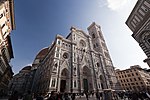 | City and Province of Florence, Tuscany 43°46′23″N11°15′22″E | 505 (1,250) | 174; 1982; i, ii, iii, iv, vi | Symbol of the renaissance with extraordinary architecture and art such as the Florence Cathedral, Basilica of Santa Croce, the Uffizi or the Pitti Palace.[28] |
| Historic Centre of Naples |  | City and Province of Naples, Campania 40°51′5″N14°15′46″E | 1,021 (2,520); buffer zone 1,350 (3,300) | 726; 1995; ii, iv | Founded in 470 BCE by Greek settlers, Naples is one of the most ancient cities in Europe. A large number of monuments such as the church of Santa Chiara or Castel Nuovo are testament of various cultures that emerged in Europe and the Mediterranean.[29] |
| Historic Centre of Rome, the Properties of the Holy See in that City Enjoying Extraterritorial Rights and San Paolo Fuori le Mura | Rome, Lazio; also: 41°53′25″N12°29′32″E | 1,485 (3,670) | 91; 1980;[nb 3] i, ii, iii, iv, vi | Rome, center of the Roman Empire and later, from the 4th century, of the Christian world is home to a large number of major monuments of antiquity. Included in the site are also religious and public buildings of the Holy See.[30] | |
| Historic Centre of San Gimignano |  | San Gimignano, Province of Siena, Tuscany 43°28′5″N11°2′30″E | 14 (35) | 550; 1990; i, iii, iv | Small medieval hill town noted for its tower-houses of which 14 survive.[31] |
| Historic Centre of Siena |  | City and Province of Siena, Tuscany 43°19′7″N11°19′54″E | 170 (420); buffer zone 9,907 (24,480) | 717; 1995; i, ii, iv | Exceptional medieval city that has preserved its gothic appearance from the 12th to 15th century.[32] |
| Historic Centre of the City of Pienza |  | Pienza, Province of Siena, Tuscany 43°4′37″N11°40′43″E | 4.41 (10.9) | 789; 1996; i, ii, iv | On decision of Pope Pius II Pienza was chosen in 1459 to be the first city to be transformed according to Renaissance Humanist ideas of urban design.[33] |
| Historic Centre of Urbino |  | Province of Pesaro, Marche 43°43′30″N12°38′0″E | 29 (72); buffer zone 3,609 (8,920) | 828; 1998; ii, iv | Small hill town with exceptional Renaissance architecture dated to a short period of cultural flowering in the 15th century.[34] |
| Isole Eolie (Aeolian Islands) |  | Southern Tyrrhenian Sea, Sicily 38°29′16″N14°56′44″E | 1,216 (3,000) | 908; 2000; viii | This archipelago features prominently in the science and education of the field of vulcanology, containing classical features of volcanic landforms.[35] |
| Late Baroque Towns of the Val di Noto (South-Eastern Sicily) | Provinces of Catania, Ragusa and Syracuse, Sicily 36°53′35.5″N15°4′8″E | 113 (280); buffer zone 306 (760) | 1024; 2002; i, ii, iv, v | Eight towns (Caltagirone, Militello Val di Catania, Catania, Modica, Noto, Palazzolo, Ragusa and Scicli) rebuilt after destruction in the 1693 earthquake, representing the pinnacle of late Baroque art in Europe.[36] | |
| Longobards in Italy. Places of the power (568-774 A.D.) | Various 46°5′39″N13°25′59″E | 14 (35); buffer zone 306 (760) | 1318; 2011; ii, iii, vi | Monasteries, churches and fortresses associated with the Longobards who settled in Italy from the 6th to the 8th century. The site is spread over seven towns in Italy (Brescia, Cividale del Friuli, Castelseprio, Spoleto, Campello sul Clitunno, Benevento and Monte Sant'Angelo). Its architecture marks a synthesis of various styles and the transition to the Middle Ages.[37] | |
| Mantua and Sabbioneta |  | Lombardy 45°9′34″N10°47′40″E | 235 (580); buffer zone 2,330 (5,800) | 1287; 2008; ii, iii | Two towns representative of Renaissance period town planning: Mantua originating in Roman times and preserving structures from the 11th century was renovated in the 15th and 16th century, while Sabbioneta was devised as "ideal town" in the second half of the 16th century[38] |
| Medici Villas and Gardens in Tuscany |  | Tuscany 43°51′28″N11°18′15″E | 125 (310); buffer zone 3,539 (8,750) | 175; 2013; ii, iv, vi | Twelve villas and two gardens built under patronage of the Medici family in the 15th to 17th centuries. They are the first example of combining aristocratic residences with gardens in a natural environment an idea that was taken up throughout Italy and Europe.[39] |
| Monte San Giorgio |  | Lombardy; also: Ticino, 45°53′20″N8°54′50″E | 1,089 (2,690); buffer zone 3,207 (7,920) | 1090; 2003;[nb 4]viii | World's best location for fossil records of marine life from the Triassic period (250 to 200 Ma).[40] [41] |
| Mount Etna | 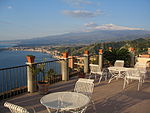 | Sicily 37°45′22″N14°59′48″E | 19,237 (47,540) | 1427; 2013; viii | As one of the world's most active volcanoes showing a diverse range of volcanic features and notable ecosystems, Mount Etna is of great scientific and cultural interest.[42] |
| Piazza del Duomo, Pisa |  | City and Province of Pisa, Tuscany 43°43′23″N10°23′47″E | 8.87 (21.9); buffer zone 254 (630) | 395; 1987;[nb 5] i, ii, iv, vi | This walled area is one of the finest architectural complexes in the world and includes four medieval masterpieces from the 11th to 14th century: the cathedral, baptistry, cemetery and the leaning tower.[43] [44] |
| Portovenere, Cinque Terre, and the Islands (Palmaria, Tino and Tinetto) |  | Province of La Spezia, Liguria 44°6′25″N9°43′45″E | 4,689 (11,590) | 826; 1997; ii, iv, v | Particularly scenic coastal area with small towns built among the steep rugged terrain.[45] |
| Prehistoric Pile dwellings around the Alps | Shared with: 47°16′42″N8°12′27″E | 274 (680); buffer zone 3,961 (9,790) | 1363; 2011; iv, v | Contains 111 small individual sites in six countries with the remains of prehistoric pile-dwelling (or stilt house) settlements in and around the Alps built from around 5000 to 500 B.C. on the edges of lakes, rivers or wetlands. While only some of the sites have been excavated, they contain a wealth of information on life and trade in agrarian Neolithic and Bronze Age cultures in Alpine Europe. All of the 19 Italian sites are located in Northern Italy.[46] | |
| Residences of the Royal House of Savoy |  | Province of Torino, Piedmont 45°4′21″N7°41′8.6″E | 371 (920); buffer zone 6,931 (17,130) | 823; 1997;[nb 6] i, ii, iv, v | Complex of buildings created to demonstrate the power of the ruling monarchy following the move of the capital to Turin by Emmanuel Philibert, Duke of Savoy in 1562. The buildings are representative of 17th and 18th century European monumental architecture.[47] [48] |
| Rhaetian Railway in the Albula / BerninaLandscapes |  | Shared with: 46°29′54″N9°50′47″E | 152 (380); buffer zone 109,386 (270,300) | 1276; 2008; ii, iv | Railway line over a total length of 128 km (80 mi) in the Swiss Alps crossing two passes in severe mountain landscapes. With 55 tunnels or galleries and 192 viaducts and bridges, it represents a notable engineering and architectural achievement while being in harmony with its environment.[49] |
| Rock Drawings in Valcamonica |  | Province of Brescia, Lombardy 45°57′25″N10°17′50″E | 432 (1,070); buffer zone 1,018 (2,520) | 94; 1979; iii, vi | Huge number of 140,000 engravings depicting scenes from agriculture, navigation, war and magic. The carvings have been created in a valley over a period of 8,000 years from the Epipaleolithic until the Roman and medieval times.[50] |
| Sacri Monti of Piedmont and Lombardy | Lombardy, Piedmont 45°58′28″N9°10′10″E | 91 (220); buffer zone 722 (1,780) | 1068; 2003; ii, iv | Nine sacred mountains (ital.: "sacri monti") with chapels and other architectural features built in the late 16th and 17th centuries for didactic and spiritual purposes. They are particularly noteworthy for the skill with which they have been integrated into a beautiful natural landscape.[51] | |
| Su Nuraxi di Barumini | 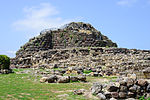 | Barumini, Province of Medio Campidano, Sardinia 39°42′21″N8°59′29″E | 2.33 (5.8); buffer zone 3.92 (9.7) | 833; 1997; i, iii, iv | Finest and most complete nuraghe settlement from the 2nd millennium BC: a unique kind of defensive structure consisting of circular defensive towers in the form of truncated cones built of dressed stone, with corbel-vaulted internal chambers, that only exists on the island of Sardinia.[52] |
| Syracuse and the Rocky Necropolis of Pantalica |  | City and Province of Syracuse, Sicily 37°3′34″N15°17′35″E | 898 (2,220); buffer zone 5,519 (13,640) | 1200; 2005; ii, iii, iv, vi | The Necropolis of Pantalica contains more than 5,000 tombs, most dating from the 13th to the 7th centuries BC, and remains of Byzantine era structures. On the other hand, the city of Syracuse includes its 8th century BC nucleus and many other remains bearing testimony to its eventful history.[53] |
| The Dolomites | 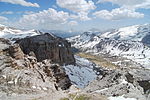 | Various 46°36′47″N12°9′47″E | 141,903 (350,650); buffer zone 89,267 (220,580) | 1237; 2009; vii, viii | Mountain range in the Northern Italian Alps with 18 peaks above 3,000 (9,800), and some of the world's most beautiful mountain scenery including sheer rocky cliffs, vertical walls, long and narrow valleys.[54] |
| The Sassi and the Park of the Rupestrian Churches of Matera |  | City and Province of Matera, Basilicata 40°39′59″N16°36′37″E | 1,016 (2,510); buffer zone 4,365 (10,790) | 670; 1993; iii, iv, v | Most outstanding example of cave dwellings in the Mediterranean with parts of it dating to the Palaeolithic.[55] |
| The Trulli of Alberobello |  | Province of Bari, Apulia 40°46′57″N17°14′13″E | 11 (27) | 787; 1996; iii, iv, v | Small town with trulli, limestone huts in a prehistoric drywall technique, usually featuring conical, domed or pyramidal roofs of corbelled stone slabs.[56] |
| Val d'Orcia | 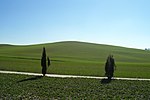 | Province of Siena, Tuscany 43°4′N11°33′E | 61,188 (151,200); buffer zone 5,660 (14,000) | 1026; 2004; iv, vi | Part of the hinterland of Siena, the landscape was carefully redesigned during the Renaissance (14th and 15th century) to reflect an idealized model of government and to create a pleasing picture. It featured prominently in paintings of the time.[57] |
| Venetian Works of Defence between the 16th and 17th centuries: Stato da Terra – western Stato da Mar | 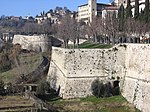 | Shared with: | 378.37 (935.0); buffer zone 1,749.62 (4,323.4) | 1533; 2017; iii, iv | Military fortifications and defensive structures created by the Republic of Venice in its mainland domains(Stato da Terra) and its territories stretching along the Adriatic coast (Stato da Mar).[58] |
| Venice and its Lagoon |  | Province of Venezia, Veneto 45°26′3.5″N12°20′20″E | — | 394; 1987; i, ii, iii, iv, v, vi | Founded in the 5th century and rising to prominence as a maritime power in the 10th century, Venice's unique location on 118 small islands harbors a large number of architectural masterpieces and major works by some of the greatest artists.[59] |
| Villa Adriana (Tivoli) |  | Tivoli, Province of Rome, Lazio 41°56′39″N12°46′19″E | 80 (200); buffer zone 500 (1,200) | 907; 1999; i, ii, iii | Villa Adriana or "Hadrian's Villa" is a 2nd-century complex of classical buildings constructed by EmperorHadrian combining architectural elements of Greece, Egypt and Rome.[60] |
| Villa d'Este, Tivoli |  | Tivoli, Province of Rome, Lazio 41°57′50″N12°47′46.5″E | 4.50 (11.1); buffer zone 7.00 (17.3) | 1025; 2001; i, ii, iii, iv, vi | Fine example of an Italian Renaissance palace and garden from the 16th century, the gardens of Villa d'Este are one of the Grandi Giardini Italiani and had a large influence on European garden design.[61] |
| Villa Romana del Casale | 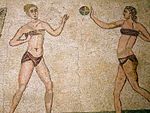 | Piazza Armerina, Province of Enna, Sicily 37°21′58″N14°20′3″E | 8.92 (22.0); buffer zone 10 (25) | 832; 1997; i, ii, iii | One of the most luxurious Roman villas built in the early 4th century and decorated with mosaics of exceptional quality.[62] |
| Vineyard Landscape of Piedmont: Langhe-Roeroand Monferrato |  | Piedmont 44°36′31″N7°57′49″E | 10,789 (26,660); buffer zone 76,249 (188,420) | 1390; 2014; iii, v | Winegrowing and processing area for Piemonte wine with a long history going back to at least the 5th century BC. The site includes the Castle of Grinzane Cavour.[63] |
| Primeval Beech Forests of the Carpathians and Other Regions of Europe | 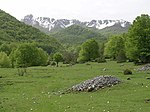 | Shared with: | 58,353.04 (144,193.5); buffer zone 191,413.09 (472,992.0) | 1133; 2017; ix | This transboundary extension of the World Heritage site of the Primeval Beech Forests of the Carpathians and the Ancient Beech Forests of Germany (Germany, Slovakia, Ukraine) stretches over 12 countries. Since the end of the last Ice Age, European beech spread from a few isolated refuges in the Alps, Carpathians, Mediterranean and Pyrenees over a short period of a few thousand years in a process that is still ongoing. This successful expansion is related to the tree’s flexibility and tolerance of different climatic, geographical and physical conditions.[64] |
Tentative List[edit]
In addition to the sites inscribed on the World Heritage list, member states can maintain a list of tentative sites that they may consider for nomination. Nominations for the World Heritage list are only accepted if the site has previously been listed on the tentative list.[65]
As of 2016, Italy was recording forty such sites on its tentative list. These sites, along with the year they were first included in the tentative list are:[2]
| Year | Name | Region | Image |
|---|---|---|---|
| 2006 | Arch of Trajan | Campania | 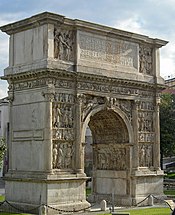 |
| 2006 | Archipelago of La Maddalena and Islands of Bocche di Bonifacio | Sardinia |  |
| 2006 | Bradyseism in the Flegrea Area | Campania | 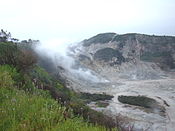 |
| 2006 | Cascata delle Marmore and Valnerina: Monastic sites and ancient hydro-geological reclamation works | Umbria and Marche | 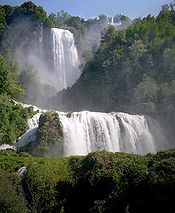 |
| 2006 | Cattolica Monastery in Stilo and Basilian-Byzantine complexes | Calabria | 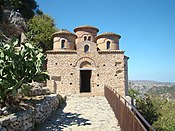 |
| 2006 | Citadel of Alessandria | Piedmont |  |
| 2006 | Hanbury botanical gardens | Liguria |  |
| 2006 | Historic Center of Lucca | Tuscany | 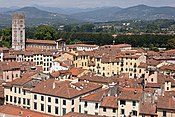 |
| 2006 | Historic center of Parma | Emilia-Romagna | 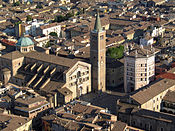 |
| 2006 | Historic center of Pavia with Certosa | Lombardy |  |
| 2006 | Island of Asinara | Sardinia |  |
| 2006 | Carsic caves in prehistoric Apulia | Apulia | 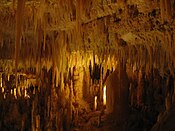 |
| 2006 | Lake Maggiore and Lake D'Orta lakelands | Lombardy and Piedmont |  |
| 2006 | Mothia Island and Lilibeo: The Phoenician-Punic Civilization in Italy | Sicily |  |
| 2006 | Orvieto | Umbria | 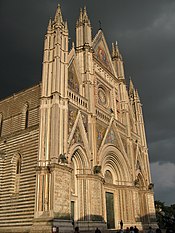 |
| 2006 | Pelagos: The Cetacean Sanctuary | Sardinia, Liguria and Tuscany |  |
| 2006 | Ponds in the Bay of Oristano and the Sinis Peninsula island of Mal di Ventre | Sardinia | 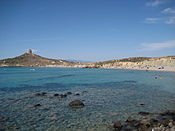 |
| 2006 | Romanesque-style Cathedrals in Apulia | Apulia |  |
| 2006 | Salento and the "Barocco Leccese" | Apulia | 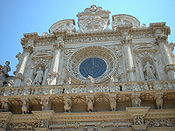 |
| 2006 | Scrovegni's Chapel in Padua | Veneto |  |
| 2006 | Sulcis and Iglesiente | Sardinia | 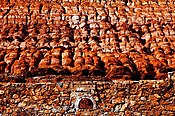 |
| 2006 | Taormina and Isola Bella | Sicily |  |
| 2006 | The Aniene valley and Villa Gregoriana in Tivoli | Lazio | 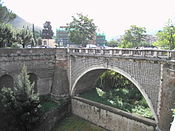 |
| 2006 | The Lower Palaeolithic Palaeosurfaces at Isernia-La Pineta and Notarchirico | Basilicata and Molise | 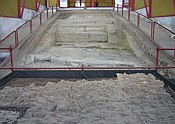 |
| 2006 | The Marble Basin of Carrara | Tuscany | 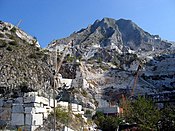 |
| 2006 | The Murge of Altamura | Apulia |  |
| 2006 | The Porticoes of Bologna | Emilia Romagna |  |
| 2006 | The Transhumance: The "Royal Shepherd's Track" (Il Cammino Reale) | Abruzzo, Apulia, Campania and Molise | 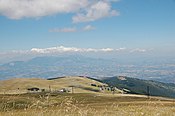 |
| 2006 | Via Appia "Regina Viarum" | Apulia, Basilicata, Campania and Lazio | 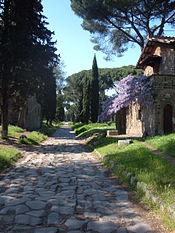 |
| 2006 | Villas of the Papal Nobility | Lazio |  |
| 2006 | Volterra: Historical City and Cultural Landscape | Tuscany | 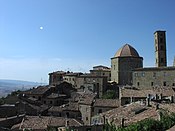 |
| 2008 | Border area of Mont-Blanc (together with France and Switzerland) | Valle d'Aosta |  |
| 2010 | The Prosecco Hills of Conegliano and Valdobbiadene. ("Le Colline del Prosecco di Conegliano e Valdobbiadene") | Veneto |  |
| 2010 | Prehistoric site of Longola [66] in Poggiomarino and Striano | Campania | |
| 2012 | Ivrea, industrial city of the 20th century | Piedmont |  |
| 2012 | Parco Nazionale della Sila – Sila, "Gran bosco d’Italia" | Calabria |  |
| 2013 | Border area of Maritime Alps - "Les Alpes de la Mer" (together with France) | Piedmont and Liguria |  |
| 2014 | Great Spas of Europe (with Austria, Belgium, Czech Republic, France, Germany and the United Kingdom) | Tuscany |  |
| 2016 | Padova Urbs Picta. Giotto, the Scrovegni Chapel and the 14th-century painting cycles | Veneto |  |


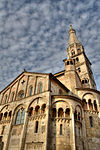






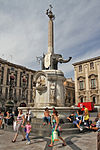



No comments:
Post a Comment